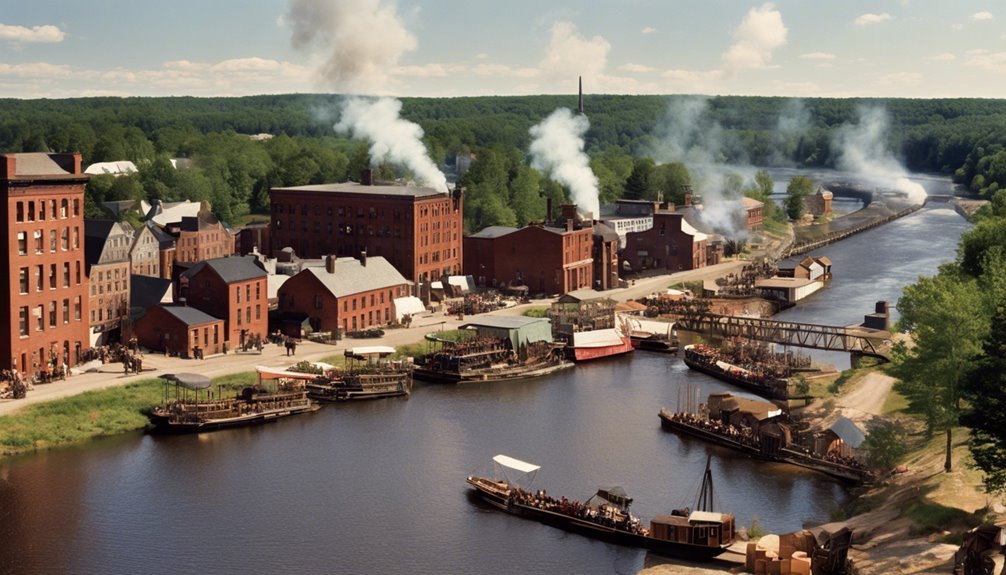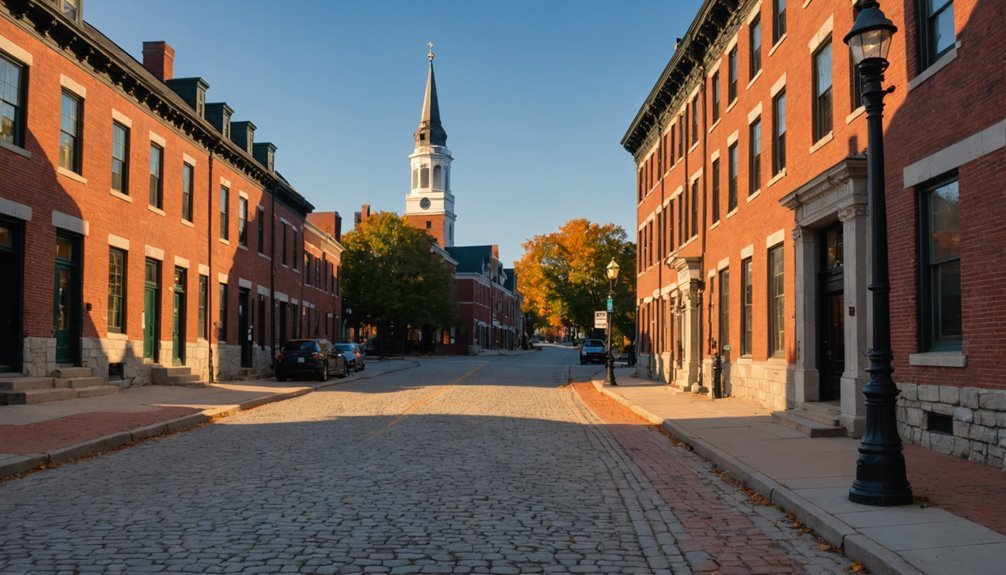When you explore Augusta’s history, you start with its roots as a strategic settlement in the early 1600s. Imagine the scene as Samuel de Champlain and other explorers navigated these lands, leading to the establishment of Koussinoc. You can trace how this small foothold evolved, witnessing the construction of Fort Western and the town’s first meeting in the late 18th century. As you uncover the layers of economic growth in textiles and education, a fascinating story of transformation unfolds. But how did Augusta balance progress with environmental sustainability? Let’s explore that intriguing question next.
Key Takeaways
- Augusta, Maine, was initially settled by Raleigh Gilbert in 1607 as Koussinoc, marking early English colonization.
- The construction of Fort Western in 1754 ensured Augusta’s safety and permanence during the French and Indian War.
- The Kennebec & Portland Railroad’s arrival in 1851 significantly boosted Augusta’s economic growth and market connectivity.
- Augusta’s first town meeting in 1784 initiated local governance and community welfare management.
- Environmental challenges such as the Great Flood of 1987 have shaped Augusta’s flood management and urban planning strategies.
Early Exploration and Settlement

Exploring the Kennebec River in 1604, explorers Pierre du Guast and Samuel de Champlain sparked European interest in Augusta, Maine. Their journey laid the groundwork for future settlements along this significant waterway.
By 1607, Raleigh Gilbert landed at Koussinoc, now known as Augusta, establishing one of the earliest English settlements in the area. This initial foothold began a series of interactions and developments shaping the region’s future.
In 1625, Edward Winslow from Plymouth established a trading post with the Kennebec Indians, facilitating essential commerce that benefited settlers and indigenous communities. This post became an important site for trading furs and other goods, fostering a relationship built on mutual need and understanding.
The strategic location of this post, known as Cushnoc, underscored its significance for early settlers.
The construction of Fort Western in 1754 marked Augusta’s first permanent settlement during the French and Indian War. Serving as a protective stronghold, it played a pivotal role in safeguarding the settlers and ensuring the continuity of the burgeoning community.
This fortification marked a new era in the region’s history, solidifying Augusta’s place in the New World.
Development of Governance
The establishment of civil government in the Augusta area started in 1654 with the Kennebec Patent, laying the groundwork for organized governance. This marked the beginning of structured administration, setting a foundation for the area’s future.
By 1784, Augusta held its first town meeting, making decisions like appropriating funds to support people with low incomes, showing early community welfare efforts and a commitment to organized governance.
As the community grew, a 1790 population census recorded 1,194 residents, prompting the construction of the first courthouse. This courthouse was a significant milestone as it established local judicial governance.
The chartering of the first bridge across the Kennebec River in 1796 improved transportation, essential for communication and governance. This development facilitated trade and interaction, vital elements for a thriving community.
The momentum continued as Augusta played a role in Maine’s journey to statehood. In 1819, a vote favored separating from Massachusetts, a pivotal step in forming a new governance structure. This decision shaped Augusta’s future and contributed to Maine’s becoming an independent state, highlighting the area’s evolving governance.
Economic Growth and Industry

Augusta’s economic roots can be traced back to its early days of fur trading, agriculture, and water-powered mills, which laid the groundwork for its eventual industrial expansion. The Kennebec River played a vital role, powering mills that transformed raw materials into goods, spurring Augusta’s economy forward.
The arrival of the Kennebec & Portland Railroad in 1851 dramatically boosted this growth by facilitating the transport of goods, connecting Augusta to broader markets.
By the late 19th century, textile manufacturing arrived with the A. & W. Sprague Company setting up cotton mills, further diversifying the industrial landscape. This period marked significant industrial growth, expanding Augusta’s economic base beyond its earlier roots.
As you explore Augusta’s development, you can’t help but feel the impact of:
- Innovation: Water-powered mills harnessing the Kennebec River.
- Connectivity: Railroads open new economic pathways.
- Diversity: A shift into textile manufacturing and beyond.
Government and education have also become essential components of Augusta’s economy. The presence of state governance and the University of Maine at Augusta provide stability and employment, making Augusta a regional hub for health and educational services.
This diverse economy guarantees Augusta remains vibrant and resilient through changing times.
Infrastructure and Transportation
Getting around Augusta is a breeze thanks to its well-structured infrastructure and transportation network. The Augusta State Airport serves both commercial and general aviation, making travel to and from the city seamless. Major access routes like Interstate 95 and U.S. Routes 202 and 201 connect Augusta to surrounding regions, enhancing overall connectivity.
Here’s a snapshot of the key transportation routes:
| Major Highways | State Routes | Environmental Considerations |
|---|---|---|
| Interstate 95 | State Route 11 | Kennebec River |
| U.S. Route 202 | State Route 3 | Flood management |
| U.S. Route 201 | State Route 27 |
State Routes 11, 3, and 27 are essential for managing regional traffic flow, ensuring daily commutes and transport efficiency remain ideal despite Augusta’s proximity to major highways. However, the city’s infrastructure planning must also account for environmental factors, such as flood management, due to its vulnerability to flooding from the Kennebec River.
These efforts are critical for maintaining the integrity of the infrastructure, ensuring that Augusta remains accessible and resilient against natural challenges. With a well-coordinated transportation system, traversing Augusta’s streets and connecting to broader networks is straightforward and efficient.
Social and Cultural Developments

Immerse yourself in the rich tapestry of Augusta’s social and cultural evolution, where early initiatives laid the groundwork for a thriving community. The construction of the first meetinghouse in 1782 served as a hub for social gatherings and religious activities, nurturing a sense of community.
By 1815, the Cony Female Academy opened its doors, marking a pivotal moment in educational history by championing gender equality. This institution provided women with unprecedented opportunities, reshaping the academic landscape of Augusta.
In 1825, the Kennebec Journal emerged as a communication beacon, enhancing the community’s access to news and information. This newspaper played an essential role in keeping residents informed and connected.
The establishment of Augusta High School in 1835 further bolstered public education, ensuring that education was accessible to all.
The Maine Farmer newspaper‘s inauguration in 1843 reflected the region’s rich agricultural roots and showcased the community’s dedication to rural issues and farming.
These developments created ripple effects that continue to influence Augusta. Reflect on how these strides have shaped the community you know today:
- Empowerment through education
- A united and informed community
- Commitment to gender equality
Environmental Challenges
While Augusta’s social and cultural landscape has thrived through education and community involvement, the city also faces significant environmental challenges due to its proximity to the Kennebec River. This river poses a risk of flooding, a threat highlighted by the Great Flood 1987. Such events have spurred Augusta to adopt proactive flood management and urban planning strategies.
You’ll likely appreciate the city’s commitment to environmental preservation, which guarantees community safety and sustainability.
Bond Brook, an essential waterway within Augusta, supports the habitat for wild Atlantic salmon, underscoring the ecological significance of these local waterways. The preservation of Bond Brook is imperative, not just for wildlife, but for maintaining the region’s natural balance.
Augusta’s efforts in this area demonstrate a dedication to protecting its natural and urban environments.
In planning its infrastructure, Augusta considers the environmental challenges of potential flooding. Adaptive urban development strategies aim to safeguard residents and property while fostering sustainable growth.
Notable Sites and Figures

When you explore Augusta, you’ll find a rich tapestry of cultural heritage landmarks, such as the Blaine House and Fort Western.
These sites capture the historical essence of Maine’s capital.
Don’t miss learning about influential figures like Olympic luge athlete Julia Clukey, who showcases Augusta’s vibrant contributions to sports and culture.
Cultural Heritage Landmarks
Augusta, Maine, is a treasure trove of cultural heritage landmarks that reflect its rich history and vibrant community spirit.
The Blaine House is a prominent cultural landmark. It is the official residence of the Governor of Maine and represents the state’s political history and architectural heritage.
Nearby, Fort Western invites you to step back into the colonial era. Built in 1754, it showcases the area’s early military history and settlement.
Don’t miss the Maine State House, an impressive structure with a 185-foot dome that symbolizes wisdom and justice.
As you explore Augusta, you’re sure to feel a deep connection to its history:
- Pride: Marvel at the beautiful Blaine House and imagine the decisions made within its walls.
- Curiosity: Wander through Fort Western and picture life during colonial times.
- Inspiration: Stand beneath the dome of the Maine State House and reflect on its significance.
Beyond these, you’ll find the Holocaust and Human Rights Center, a center for human rights education.
Viles Arboretum offers a lush space for community engagement and environmental education, showcasing Augusta’s commitment to preserving natural beauty.
Influential Local Personalities
Amidst Augusta’s rich tapestry of cultural heritage landmarks, the city boasts a legacy of influential personalities who have left indelible marks on its history. The Blaine House stands proudly as an emblem of political heritage, serving as the Governor’s residence and a symbol of Augusta’s historical significance. You can explore its storied halls during public tours, offering a glimpse into the lives of Maine’s leaders.
Not far from there, Fort Western reflects Augusta’s military presence. It is the oldest surviving wooden fort in the U.S. and offers insight into the city’s colonial past and the notable figures who defended it.
Meanwhile, human rights advocacy takes center stage at the Holocaust and Human Rights Center of Maine. Located at the University of Maine at Augusta, it highlights the city’s commitment to education and justice.
| Landmark/Site | Significance | Related Personality |
|---|---|---|
| Blaine House | Governor’s residence, historical significance | Political leaders of Maine |
| Fort Western | Oldest wooden fort, military presence | Colonial military figures |
| Holocaust and Human Rights Center | Human rights advocacy | Human rights activists |
Among Augusta’s influential local personalities, Julia Clukey shines as an Olympic luge athlete, proudly representing the city internationally. The Maine State House, with its majestic dome, also stands as a symbol of the city’s enduring legacy.
Conclusion
You’ve journeyed through Augusta’s rich history, from early exploration to becoming a thriving hub. You’ve seen how governance evolved, industries flourished, and infrastructure expanded while maintaining a balance with nature. Augusta’s social and cultural developments highlight a community committed to growth and sustainability. As you explore its notable sites and remember its influential figures, you’ll appreciate how Augusta’s past shapes its vibrant present, making it a unique and enduring city in Maine.
FAQs
1. What Is Augusta Maine Famous For?
Augusta, Maine, is famous for its rich Maine culture, including Augusta landmarks like Fort Western. Experience historic events, local cuisine, outdoor activities, a vibrant art scene, educational institutions, and community festivals celebrating its unique heritage.
2. Why Did Maine Change Their Capital From Portland to Augusta?
Maine’s capital relocation reasons involve historical significance and political considerations. Augusta’s geographical advantages outweighed Portland’s coastal location. Economic factors and civic development influenced legislative impact, while community reactions favored Augusta for accessibility and defensibility.
3. How Did Augusta Maine Get Its Name?
Augusta’s origins are in colonial history when native tribes named it Cushnoc. Renamed for Pamela Augusta, honoring historical figures, its etymology reflects classical influences. Local legends and geographical significance sparked naming controversies, shaping Augusta today.
4. What Was the Capital of Maine Before Augusta?
You’d find that before Augusta, Portland was the capital. Its historical significance lies in Maine’s geography and early settlers. The state government moved due to capital relocation, fostering Augusta’s development and influencing Maine architecture.

